|
|
|
Sort Order |
|
|
|
Items / Page
|
|
|
|
|
|
|
| Srl | Item |
| 1 |
ID:
084229
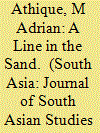

|
|
|
|
|
| Publication |
2008.
|
| Summary/Abstract |
This article examines the visualisation and narrative construction of the India-Pakistan border, and human interactions across that liminal space, as depicted in two films directed by J.P. Dutta, the high-profile, multiple award-winning war film Border (1997) and his subsequent feature Refugee (2000), which was more loosely described in its publicity literature as 'a human story'. 1 Through these films, Dutta established his reputation as the leading Indian director of the 'war film', a genre marked by its relative absence in the Indian cinema prior to the 1990s. Both Border and Refugee thus constitute part of what has retrospectively been described as Dutta's 'war trilogy' (along with the more recent LOC Kargil of 2003, which focuses on the 1999 Himalayan conflict). 2 In the first two films of the set, which I will consider here, the border in question is not the Line-of-Control (LOC) that divides Kashmir, but rather the southern portion of the long border with Pakistan that runs from the southern bank of the Sutlej River across the Thar Desert to the Arabian Sea. Refugee, moreover, is not a war film in the accepted sense, and I will make the argument that it is not so much the martial posturing which constructs the thematic inter-relation of the two films considered here but rather their attempts to naturalise the abstract barrier created by the Radcliffe Line in the west.
|
|
|
|
|
|
|
|
|
|
|
|
|
|
|
|
| 2 |
ID:
083668
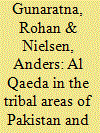

|
|
|
|
|
| Publication |
2008.
|
| Summary/Abstract |
After the U.S. led coalition forces attacked Al Qaeda and Taliban infrastructure in Afghanistan beginning in October 2001, the epicenter of global terrorism moved from Afghanistan to tribal Pakistan. Known as the Federally Administered Tribal Area (FATA) in Pakistan, this region has emerged as the premier hunting ground for the Al Qaeda leadership. With the co-option of new groups in FATA and its adjacent North Western Frontier Province (NWFP), the Al Qaeda threat has proliferated. The threat posed by the Afghan Taliban has been compounded with the addition of a new range of actors notably the Pakistani Taliban. Working together with multiple threat groups, both foreign and Pakistani, Al Qaeda directs its global jihad campaign from FATA. Unless the terrorist enclave is cleared on the Afghan-Pakistan border, the threat to Afghanistan and mainland Pakistan will continue. This article seeks to map the evolution of Al Qaeda and its associated groups since their relocation to FATA.
|
|
|
|
|
|
|
|
|
|
|
|
|
|
|
|
| 3 |
ID:
101667
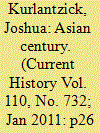

|
|
|
| 4 |
ID:
154868


|
|
|
|
|
| Summary/Abstract |
Between 1948 and 1967, Jerusalem was divided by a ‘city line’, dividing Jordan (East Jerusalem) from Israel (West Jerusalem). Between the two sections stood one border crossing called ‘Mandelbaum Gate’. While existing literature on the Gate tends to emphasize its military status – owing in particular to the military convoy that crossed the border on a regular basis – research using sources from that time paints a picture of a border with civilian activity run jointly by two ostensibly warring countries. Whether it was the return of civilians and bodies, tourism coordination, or medical passage, those manning the border worked together to make it bridge, rather than barrier – and may even have paved the way to a peace agreement years later.
|
|
|
|
|
|
|
|
|
|
|
|
|
|
|
|
| 5 |
ID:
079641
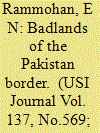

|
|
|
| 6 |
ID:
180305
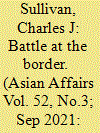

|
|
|
|
|
| Summary/Abstract |
The deadly skirmishes along the disputed border of Kyrgyzstan and Tajikistan in late April 2021 stand out in comparison to other recent clashes between residents of this remote area. This article analyzes the 2021 border conflict. Furthermore, it stands to reason that the current political climate serves to hinder any resolution to this interstate dispute. Lastly, since skirmishes between Kyrgyzstan and Tajikistan (both members of the Collective Security Treaty Organization) serve as a source of potential embarrassment for the Russian Federation, Moscow will seek to assert its leverage, in the hopes of avoiding future clashes and maintaining its hegemony over Central Asia.
|
|
|
|
|
|
|
|
|
|
|
|
|
|
|
|
| 7 |
ID:
160403
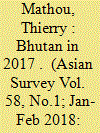

|
|
|
|
|
| Summary/Abstract |
Bhutan’s agenda in 2017 was dominated by the preparation for the third parliamentary elections (slated for 2018), the 12th Five-Year Development Plan (2018–23), and the golden jubilee of the establishment of diplomatic relations with India. A military standoff between China and India on Bhutan’s border highlighted the kingdom’s strategic regional position.
|
|
|
|
|
|
|
|
|
|
|
|
|
|
|
|
| 8 |
ID:
172479
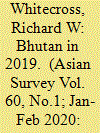

|
|
|
|
|
| Summary/Abstract |
Bhutan in 2019 was dominated by the change of government in late 2018, better diplomatic relations with India, and cultivation of relations with China. The economy was strong, with the country due to graduate from least developed country status in 2023, though unemployment is a concern.
|
|
|
|
|
|
|
|
|
|
|
|
|
|
|
|
| 9 |
ID:
179262
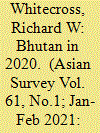

|
|
|
|
|
| Summary/Abstract |
The year 2020 in Bhutan was dominated by the coronavirus pandemic, a decline in state revenues, and territorial claims by China. In 2019, Bhutan’s strong economy suggested that the country would graduate from the least developed country category in 2023. The economic impact of the coronavirus pandemic on the economy makes this less certain.
|
|
|
|
|
|
|
|
|
|
|
|
|
|
|
|
| 10 |
ID:
098372
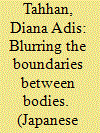

|
|
|
|
|
| Publication |
2010.
|
| Summary/Abstract |
Touch, as it is conventionally conceived, appears to be lacking in everyday Japanese intimate relationships, which are accordingly commonly characterised in terms of subtle non-tactile and non-verbal forms of communication; feelings are expected to be inferred. However, it is unclear as to how such forms manifest feelings of closeness in the first place. This paper explores the embodied experience in the intimate spaces of the Japanese family. Japanese parent-child relationships help us to become acquainted with different ways of understanding bodily intimacy and touch. The paper explores the cultural meaning of touch in Japanese bodily intimacy, particularly where the child is under five years old, and presents an embodied and sensuous understanding of the touch which informs parent-child relationships as the child grows older. Certain phenomenological tools are used helping to develop the notion of a blurring of the boundaries between bodies in Japanese bodily intimacy.
|
|
|
|
|
|
|
|
|
|
|
|
|
|
|
|
| 11 |
ID:
177727
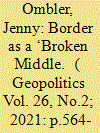

|
|
|
|
|
| Summary/Abstract |
Critical border studies is increasingly articulating ethical approaches to borders and bordering practises. In this paper, I heed this impulse, by articulating a notion of the border as a ‘broken middle’ in which the bounds of the absolute are challenged and held answerable for injustices. The ‘broken middle’ is a concept developed by British theorist Gillian Rose, for whom it represents a dialectic conceptual space both between and within apparent binaries. The broken middle requires a reassembly of the bounds of each—a confrontation of self—in the pursuit of an evasive yet hopeful ethics. The application of the broken middle to the border illuminates the ambiguities of its physical space, and the ways in which bordering practises represent the imposition of unjust binaries. I finish by considering how a work by Beit Sahour-based collective, Decolonising Architecture Art Residency (DAAR), begins the difficult, pragmatic, and ever-hopeful work of the broken middle in the border.
|
|
|
|
|
|
|
|
|
|
|
|
|
|
|
|
| 12 |
ID:
100458


|
|
|
| 13 |
ID:
106147
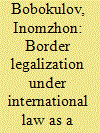

|
|
|
| 14 |
ID:
095990
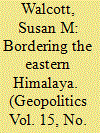

|
|
|
|
|
| Publication |
2010.
|
| Summary/Abstract |
National borders in the eastern Himalaya region exhibit pressures of modernisation transition between two powerful emerging nation-states. The research question concerns under what circumstances borders are maintained. Consideration falls on the role of physical features, borders as cultural identity markers, and passes as transgressive spaces, negotiated through historical shifts in population and politics. A geopolitical history of boundary contestations in this region indicates the role of passes as conduits of political and cultural flows. Power relations bound space that cultural preservation makes worth delimiting.
|
|
|
|
|
|
|
|
|
|
|
|
|
|
|
|
| 15 |
ID:
104427
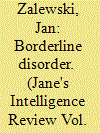

|
|
|
| 16 |
ID:
126898
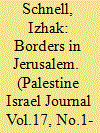

|
|
|
|
|
| Publication |
2011.
|
| Summary/Abstract |
Borders may be understood as one of the basic elements that constitute territories. Territories are homogeneous bounded spaces that are associated with the existence of species and control over space. Borders are the lines the demarcate and limit territorial expanses. The systematic study of territorial control and boundaries is common in geographical studies, mainly in the study of national borders.
|
|
|
|
|
|
|
|
|
|
|
|
|
|
|
|
| 17 |
ID:
081356
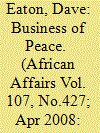

|
|
|
|
|
| Publication |
2008.
|
| Summary/Abstract |
Peace work is big business along the Kenya-Uganda border. Each year, new groups are created thanks to the generosity of major donors while others disappear due to corruption and mismanagement. This cycle has continued for decades and, despite an absence of tangible results, millions of dollars continue to flow into the bank accounts of peace groups in the North Rift. As the first part of this article suggests, the focus on the so-called 'root causes' of violence may well be responsible for the dismal performance of the peace industry. However, the behaviour of peace NGOs in the field has been appalling. Peace meetings are often only held so NGOs can display an engagement with the conflict, despite the dangers created by such events. Other groups are dominated by politicians who use money earmarked for peace work to fund their political ambitions. Better monitoring is the obvious solution, but local groups have been able to avoid this by exaggerating the security risks of visiting the region. Others argue that offloading peace work responsibilities to CBOs might lead to better results, but in the highly ethnicized North Rift smaller groups are rarely able to transcend their local roots. This article concludes that the peace industry is deeply flawed, and requires a complete overhaul in order to have a beneficial impact on the region.
|
|
|
|
|
|
|
|
|
|
|
|
|
|
|
|
| 18 |
ID:
105015
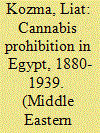

|
|
|
|
|
| Publication |
2011.
|
| Summary/Abstract |
This article examines Egypt's stance on cannabis prohibition, from the 1870s ban on cultivation and consumption, to the role Egypt played in the international ban on traffic in cannabis, in the 1924-25 International Opium Conference. Relying on Egyptian polemic writing, British correspondences and League of Nations documentation, this article argues that elite concerns with national modernity, rather than merely British colonial interests, motivated Egyptian drug policy and diplomacy. This article further demonstrates the effects of the Egyptian ban on consumption, as well as on production - across and beyond national borders.
|
|
|
|
|
|
|
|
|
|
|
|
|
|
|
|
| 19 |
ID:
125237
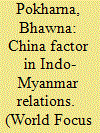

|
|
|
|
|
| Publication |
2013.
|
| Summary/Abstract |
Myanmar has two great and powerful neighbours, India to the Northwest and China to the Northeast. It has Bangladesh to the West, Laos to the East and Thailand to South East. Myanmar's long coastline with good harbors enables it to dominate the Bay of Bengal. Myanmar Shares 2171 kilometres Long border with China whereas with India it shares 1643 kilometres of border. Myanmar lies where South, South East and Asia meet - there the dominant cultures of these sub-regions compete for influence.
|
|
|
|
|
|
|
|
|
|
|
|
|
|
|
|
| 20 |
ID:
076725
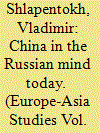

|
|
|
|
|
| Publication |
2007.
|
| Summary/Abstract |
This article describes the ambivalence of Russian attitudes toward China at the beginning of the twenty-first century. Russians of all strata combine a willingness to see China as a friendly neighbour with a high level of fear of the giant that could swallow much of the country whole, especially the Asian part. The article pays special attention to the split in Russian views of China among elites. While some elites, who have strong anti-American attitudes, see China as a major ally against the United States, others call on the government to treat the United States as the single force that can help Russia protect the integrity of its territory against China, whose people still do not recognise the existing borders between the two countries.
|
|
|
|
|
|
|
|
|
|
|
|
|
|
|
|
|
|
|
|
|